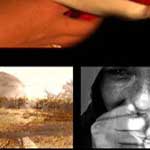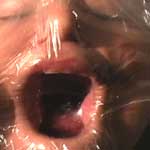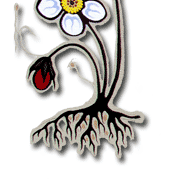|
Saturday, June 21
VIDEO SCREENINGS:
(post) Colonial Stress Disorder:
imaging a way out
Curated by Wanda Nanibush
This program was first presented
by WARC Gallery
in 2007. Read the essay by curator Wanda
Nanibush...
| Special added screening: World premiere
of a new short film by Shelley Niro: The
Flying Head |
8 pm at the Gordon Best Theatre
216 Hunter St. W., Peterborough
(above the Only Cafe)
Films:
Divided by Zero. Danis
Goulet, Canada, 2006, 16:17
Portrait in Motion. Nadia
Myre, Canada, 2002, 2:21
Love & Numbers. Thirza
Cuthand, Canada, 2004, 9:00
1,2,3, Knock up. Ariel
Smith, Canada, 2006, 4:16
The Weave. Cherie
Valentina Stocken, Canada, 2005, 5:36
Prayer for a Good Day. Zoe
Leigh Hopkins, Canada, 2003, 12:12
The Knot Between. Cherie
Valentina Stocken, Canada, 5:14
This program highlights six emerging Indigenous
voices within media arts today.
|
Divided by Zero
Danis Goulet,
Canada,
2006, 16:17
|
The first filmmaker is Danis
Goulet who's second short drama Divided by
Zero follows a young Cree woman in the city
as she struggles to both enact social change and define
what it is to be Cree. She builds herself a tipi, burns
sweetgrass and paints her face because an 'innocent'
comment by her boyfriend's mother leaves her unmoored
in her 'Cree-ness.' The film brings to light the discourses
on Indian-ness that one must negotiate in order to even
be politically active or to love. It subtly critiques
both the idea that Cree ness could be so easily located
inside a tipi and critiques the appropriation of notions
of Aboriginal spirituality by some activist movements.
Possibly her Cree-ness is located in her fight against
'Blood for Oil." To be divided by zero is zero,
taken as a visual image it is to be a whole. Wholeness
does not necessarily mean lack of contradiction or confusion.
|
|
Portrait in Motion
Nadia Myre,
Canada,
2002, 2:21
|
Nadia Myre's
arresting Portrait in Motion takes another
approach to the same problem. She constructs herself
in the metallic coloured morning paddling a canoe through
the mist. She monumentalizes herself. The difference
becomes apparent as the statue-portrait moves, closer
and closer, until you are staring her in the face. Her
sweatshirt and direct gaze undo the myth of the vanishing
Indian. The face-to-face moment asks us to accept what
we cannot see or know of her and to be critical of how
we see or know her. She may also be recuperating the
canoe as a mode of transportation that belongs to Indigenous
technological innovation
|
|

Love & Numbers
Thirza Cuthand, Canada,
2004, 9:00
Click
to see still...
|
Love & Numbers
by Thirza Cuthand is a complex
rendering of the breakdown of meaning brought about
by the violation of colonialism. She speaks of all the
'codes' she receives; from her ancestors, from colonial
narratives, from the hospital, from her heart in love.
She marks out the pain and confusion in being unable
to navigate through the competing narratives of who
she in order to be able to transmit, to signifying her-self.
The inability to signify this rupture in her being or
to bring to speech the deep trauma gets recodified within
the hospital as her 'craziness.' As she says: "I
only wanted to create a world where I could be loved."
Love is a relation that resists any kind of binary code.
|
|

1,2,3 Knock up
Ariel Smith
Canada,
2006, 4:16
Click
to see still..
|
Ariel Smith
in navigates her way through a number of narratives
and experiences that make a horror of girlhood. In a
film that references Lynch as much as Citizen Kane,
Smith breaks new ground in displaying the relationship
between image and meaning. Her film is open to multiple
interpretations but for me, she recuperates female subjectivity
and girlhood from a suffocating sexualization.
|
|

The Weave
Cherie Valentina Stocken,
Canada,
2005, 5:36
Click
to see still...
|
The Weave by Cherie
Valentina Stocken is a visual representation of
the crack within the Indigenous psyche. The screen is
divided into four mini screens. The centre image of
a horizontal triptych on the screen is a close up shot
of a grieving woman. You see her scream and cry. The
left screen of the triptych shows a woman standing in
a field wearing European dress. English handwriting
scrolls over the screen reminding us of the colonial
journals that continue to define us. The right screen
of the triptych is a woman in what is probably pow wow
regalia. The screen is covered in Cree syllabics. Unlike
the European women the Aboriginal women stands with
a ghosted picture of her ancestors behind her. Possibly
pointing to the white women who came here alone to 'birth
a new white nation' and to the Aboriginal women's location
within community. Above the triptych are hands weaving
red and white cloth. This could symbolize the Canadian
flag. The weaving could be the national impulse to incorporate
(assimilate) the Aboriginal Peoples within its narrative
of origin. It could point out the necessity of the images
of Aboriginal Peoples that circulate in Canadian society
for defining what is Canadian at the same time as they
ignore 'real' Indigenous Peoples. It definitely points
out Stocken's need to weave her white and Aboriginal
histories into her current identity. The motion of weaving
hails forward the braiding of sweetgrass and the teachings
it contains. As the grieving women's hands begin to
weave, she smiles. The song switches from Jesus loves
me back to the childhood lullaby. Her healing lies within
a weaving that we do not see the beginning or ending
of. Conflicting narratives and lineages are being weived
endless til there is just the motion of the weaving
itself to signify identity and wholeness.
|
|

Prayer for a Good Day
Zoe Leigh Hopkins, Canada,
2003, 12:12
Click
to see still...
|
Prayer for Good Day
by Zoe Leigh Hopkins takes grief
straight into the Aboriginal community and points to
its generational effects. The silence of the little
girls father can be read as the always already of colonial
trauma and its unspoken effects. The daughters resilience
and periodic joy show how the community goes on despite
the supposed-to-be-debilitating effects of policies
of assimilation and segregation. Hopkins shows how colonialism
reached its hand into the home breaking millennial old
family relations and codes of love.
|
|

The Knot Between
Cherie Valentina Stocken,
Canada,
5:14
Click
to see still...
|
The closing film is The Knot
Between by Cherie Valentina
Stocken which marks out the difficulty of the in-between
and its asyphixia of meaning. It viscerally symbolizes
both how we are suffocating under signs we have not
chosen and that this struggle for place, for definitional
control, for meaning is a matter of life and death.
When her suffocation speeds up, we can feel it in our
own body. We feel with her the relief of a life-giving
breath.
|
Filmmakers:
Danis Goulet's short films have
screened at numerous festivals in Canada and around the world,
including the Sundance Film Festival, the Native American
Film + Video Festival in New York, and the Message Sticks
Film Festival in Sydney, Australia. She sits on the Board
of the Images Festival, the Visual/Media Arts Committee of
the Toronto Arts Council, and the programming committee of
the Worldwide Short Film Festival. Danis is Métis,
originally from northern Saskatchewan. Divided by Zero
is Danis's second short drama.
Nadia Myre is a multidisciplinary
artist whose work has exhibited nationally and internationally.
She has been the recipient of the prestigious Eiteljorg fellowship
and her work is in the Council Art Bank, Canadian Museum of
Civilation, and the Indian Art Centre and many other collections.
Myre has made four short videos.
Thirza Cuthand was born in Regina,
Saskatchewan, in 1978, and grew up a Cree Scots Irish bipolar
butch lesbian two spirited boy/girl thingamabob in Saskatoon.
She has produced award winning experimental videos and films
on low to no budget exploring issues of identity, race, sexuality,
relationships, ageism, and mental health. Her work has been
shown at the Walter Art Centre, the Mackenzie Art Gallery,
Oberhausen International Short Film festival, the San Francisco
Gay and Lesbian Film Festival, The Women's Television Network,
MIX NY, the Walter Phillips Gallery, the Mendel Art Gallery,
the MIX Brasil festival of Sexual Diversity, and many other
places. She majored in film and video at Emily Carr Insititute
of Art & Design.
Ariel Smith is from the Cree/Ojibway
First Nations. She is also Roma and Jewish. She was born a
few years ago on Coast Salish land commonly known as Vancouver.
Ariel has written , directed and produced video shorts and
one super 8 short film. Her videos have screened at festivals
and events around North America and overseas.
Cherie Valentina Stocken's work
deals with issues of cultural convergence and the role history
plays in defining cultural relationships. Stocken has received
her BFA from the University of British Columbia and has exhibited
both nationally and internationally. It is Cherie's goal to
continue to inspire social change throughout her art career.
Cherie is English, Saulteaux, Cree, German and French from
Gordons Reserve, Saskatchewan.
Zoe Leigh Hopkins graduated
in 1997 from Ryerson with a B.A.A. in Film. Zoe was a Fellow
at the Sundance Institute's January 2004 Screenwriter's Lab
with her feature script, Cherry Blossoms. Her short film Prayer
for a Good Day had its world premiere at the 2004 Sundance
Film Festival. Zoe is Heiltsuk from Bella Bella and Mohawk
from Six Nations.
Distributors:
Vtape Distribution
401 Richmond Street West, Suite 452
Toronto, Ontario M5V 3A8
416.351.1317
416.351.1509
Wanda Vanderstoop wandav@vtape.org
Titles: Divided by Zero, Prayer for a Good Day, The Knot
Between, The Weave, Love & Numbers, 1, 2, 3, Knock up
Nadia Myre
www.nadiamyre.com
514 284 2444
Title: Portrait in Motion
(post) Colonial Stress
Disorder
'imaging a way out"
written and curated by Wanda Nanibush
There is a considerable amount of writing today decrying
the dangers of identity politics and much laughter and resentment
over political correctness. This debate missed the mark and
never discovered what was actually being demanded from within
identity politics. The demand was not be included or tolerated
or even understood. It was a demand to redefine the meaning
and shape of contemporary society from the position of all
that it excluded. The inclusion of Indigenous Peoples is really
about remaking society from within our understandings of what
it is to be human, to be political, to be a society, to be
lawful etc. To be sovereign has always been about self-determination,
not in terms of what can be accommodated in the system already,
but in terms of changing the system entirely. Identity, taken
to be fluid and multiple, is necessarily political. 'Identity
politics' was also not about replacing one definition for
a cultural one. It was about clearing space for us to have
a discussion with ourselves about who we are, who we were
and how we want to be.
The six emerging Indigenous filmmakers in this program show
that the fight over meaning, (over the symbolic) is not over,
Indigenous Peoples are still struggling for sovereignty over
their own self-definition, still struggling to breath under
the weight of someone else's view of them. This fight is not
just over words and images, it is about how words and images
have violent material consequences. The struggle over the
symbolic order is a struggle to be recognized from within
one's difference as Indigenous (not a fixed term). It is also
a struggle for land. If we lose the fight over our own representation
we could lose the fight over the land. History has shown how
images and words defining who Indigenous Peoples are can justify
political and social violence. The struggle over self-definition
and meaning is a struggle over matter- I want to matter, to
count, to be counted, and to be spoken into being.
There is a crack in the Indigenous psyche between that which
is written about us and our understanding of that writing.
The crack itself is a subjectivity that can not find voice,
a subjectivity unrecognizable in the terms we are given within
the English language. The invasion and imposition of signifiers
of Indian-ness - dance, dress, tipi, feathers - all have another
history and context. These signifiers of Indian-ness once
belonged to very specific and diverse Indigenous cultures.
They get reframed in the films as significations not of Indian-ness
but of connections to community and ancestry. Both the critique
of stereotypes and the recuperation of these symbols of identity
lead us closer to a future of Indigenous specificity and uniqueness.
They become modes of collective healing and mutual recognition.
The materiality of being indigenous lies also in sovereignty
over defining identity, culture and place. The in between
space we inhabit is not the hybridization of culture but the
inbetween within the conflict of not having regained our sovereignty.
These films ask what is my responsibility politically and
culturally to the history I have arrived in and the future
I create in the present. They also ask the viewer to question
their own conceptions of what they see, to accept responsibility
for their part in the current confusion and pain of meaning,
they face us with the impossibility of unity and complete
understanding.
The desire for belonging, memory, and history
is a nostalgic dream brought to the fore in the trauma of
colonialism. Our nostalgia for the past is really nostalgia
for a future. These films point out that we never went anywhere
but it's a struggle to ontrol where we are going. The break
in our pasts connection to our present is not due to a loss
of culture but to a political violence that we still experience.
The break is due to a loss of sovereignty over the meanings
of our cultures and over the lands we inhabit. The ethical
responsibility for us all is to honour and help create the
breathing space being demanded. A breathing space for a unique
specific subjectivity for all Indigenous Peoples, be they
Métis, Anishnawbeg, Cree, urban, reserve, mixed blood,
adopted or whomever they wish to be in all their complexity.
• • • • • •
Wanda Nanibush is an independent curator, writer and
emerging media artist. She lives in Ottawa, studies film at
Carleton and raises her son. Wanda is Anishinabe-kwe from
Beausoleil First Nation. In her other life as a consultant
she helps arts organization develop, change and grow. Nanibush
also helps communities develop arts programming and infrastructure.
The Flying Head
by Shelley Niro
Canada, 2008, 4:00, bw
Co-presented with The Peterborough Arts Umbrella
In the olden days the bogey man was a common scare tactic
to get kids to react to the adult voice. On the Six Nations
Reserve, the bogey man was "the flying head". Threats
of seeing bizarre and horrible things were used to get children
into the house after dark. It usually worked. In the contemporary
world we can laugh at these basic employs, but are they really
fantasy as we pretend them to be?
Shelley Niro is a member of the Turtle Clan of the
Kanien’kehaka (Mohawk) Nation, from the Six Nations Reserve
near Brantford. She was born in Niagara Falls, New York in
1954, and has studied at the Banff School of Fine Arts, is
a graduate of the Ontario College of Art, and received her
MFA from the University of Western Ontario. Working in a variety
of media, including beadwork, painting, photography, and film,
Niro challenges stereotypical images of Aboriginal peoples
through strategies of masquerade, parody, and appropriation.
Often using herself, friends, and family members as subjects,
the artist creates depictions of Aboriginal peoples in counterpoint
to those generated by centuries of colonization. Through her
often direct yet humorous approach the artist proposes numerous
possibilities for lived experience, presenting identity as
a fluid and complex state, not one that is fixed and singular.
Her work has been exhibited in galleries across Canada and
her award-winning films have been screened at festivals worldwide.
Her art can be found in the collections of the Canada Council
Art Bank and the Canadian Museum of Civilization, and now
here in NAICA online’s Spring edition! For more information
on Niro visit www.thenaica.org/edition_eight/air/intro.htm
where she is the North America Indigenous Cinema and Arts
featured artist in residence for Spring 2008.
|

